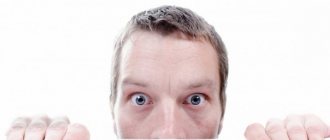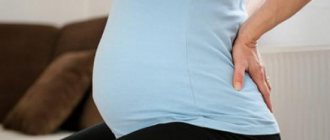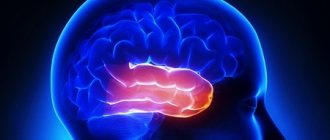To the main symptoms of panic attacks (F41, ICD-10) refers to repeated attacks of severe anxiety, unpredictable in nature, independent of the situation or circumstances. As a rule, an attack of panic attack is accompanied by rapid heartbeat and chest pain, up to the fear of dying from cardiac arrest, a feeling of lack of air, nausea, states of depersonalization and derealization, fear of losing control over oneself and going crazy.
It is important to distinguish between the signs of panic attacks and attacks of normal anxiety. Anxiety is a negatively colored emotion, a premonition that is uncertain regarding the nature of expected events. The causes of anxiety, unlike specific fears, are not objective. In other words, anxiety helps to avoid potentially unwanted situations and their consequences. It becomes the cause of actions that determine a favorable vector of events in an alarming situation.
As for a panic attack, it is a sudden, causeless attack of pronounced anxiety, accompanied by fear and various somatic symptoms. In other words, the clinical signs of panic attacks must necessarily be accompanied by a type of anxiety in which it is impossible to establish the cause of the fear. The nature of such anxiety cannot be explained by the person himself, even at its peak, except as fear for his own life and sanity.
Symptoms and signs of panic attacks
In the clinical picture of the disease, the leading symptoms and signs of panic attacks are strong fear that cannot be rationalized, disturbances in the functioning of the respiratory organs and cardiovascular system, and other phenomena of a vegetative nature. As a rule, the attack occurs instantly and lasts about 15–30 minutes.
The incidence of panic attacks varies from moderate (F41.00, ICD-10) to severe (F40.01, ICD-10). Moderate episodic paroxysmal anxiety corresponds to - from 4 attacks over a distance of 28 days; severe - at least 4 attacks in 7 days at a distance per month.
As a rule, the individual picture of an attack includes the following symptoms and signs of panic attacks:
- cardiopalmus;
- chest discomfort;
- tingling in the heart area;
- rise in blood pressure;
- feeling of lack of air;
- labored breathing;
- dizziness;
- sweating;
- “waves” of heat and cold;
- nausea;
- diarrhea (sometimes).
Objectively, during an attack, those around you can record a change in the color of the skin, sweating, a rise in blood pressure, a high pulse rate, difficulties with coordination of movements, and tremors. However, both the person himself and the people around him usually mistake the symptoms of panic attacks for signs of a heart attack or stroke (especially at the onset - the first attack of PA).
In some cases, with a weak mental constitution (low threshold of resistance to stress factors), a severe panic attack can lead to loss of consciousness. With repeated attacks of PA, anticipatory anxiety develops quite quickly, expanding the range of negative experiences with the fear of expecting an attack. In addition, agoraphobia and restrictive behavior may appear in the clinical picture.
Rice. 1. The mechanism of a panic attack.
Symptoms of panic attacks in women
Clinical practice shows that women are more susceptible to episodic paroxysmal anxiety than men. The symptoms of panic attacks in women are not much different from the signs of the “male” version of the disease. However, they still affect the health and adjust the life of an adult woman.
The main symptoms of panic attacks in women include:
- menstrual irregularities;
- other endocrine disorders affecting reproductive function;
- increased risk of developing neurotic and depressive disorders;
- alcoholism according to the female type.
In addition, the development of the disease can cause disruption in a woman’s functioning in the family, even leading to the risk of divorce proceedings. Indirectly, the disease inevitably affects both men and children, becoming the cause of “secondary” psychopathology, including developmental disorders of the mental apparatus in children.
Symptoms of panic attacks in men
Symptoms of panic attacks in men can radically change a person’s life, masking the disease under character traits, lifestyle, or unusual creeds. Outside of marriage, it is quite difficult for such a person to maintain a relationship; in marriage - to preserve the family or relationships in it, to create favorable conditions for raising children, the healthy development of their mental apparatus.
Typical symptoms of panic attacks in men that affect quality of life include:
- problems with potency;
- risk of developing severe depression with suicidal tendencies;
- rapid alcoholization, interest in surfactants.
If the picture of the disease is dominated by depressive tendencies, alcoholism or addiction to psychoactive substances quickly develops, and there is a high risk of suicidal tendencies. Most successful attempts to commit suicide during the course of the disease are observed in men.
Symptoms of panic attacks in teenagers and children
As a rule, severe symptoms of panic attacks in adolescents can be detected between the ages of 7-10 years. First of all, they manifest themselves in an unusual deterioration in the well-being of children, a decrease in mood and activity. Within an educational institution, such a child may become a victim of bullying or violence from classmates, fall behind in academic performance, and withdraw into himself.
Symptoms of panic attacks in adolescents that occur against a background of increased anxiety or fear attacks include:
- decreased tone;
- fast fatiguability;
- frequent headaches;
- gastrointestinal disorders;
- increased sweating;
- cardiopalmus;
- pain in the heart area;
- dyspnea.
Unfortunately, symptoms of panic attacks in children are not detected in a timely manner. Parents can search for a long time for the true reason for the deterioration of their child’s well-being, visiting doctors of various specializations year after year, ignoring treatment for panic attacks by a child psychiatrist or neuropsychiatrist. However, having learned to cope with attacks of PA, such a child becomes “adapted” only externally, maintaining psychopathology in potency. Having entered adulthood, such children have a high probability of relapse of the disease and, consequently, its development.
Rice. 2. Types of reaction to stress and panic attack.
How to cure panic attacks without medications?
To get rid of anxiety attacks, it is necessary to cure the disease itself, which provoked them. It is not recommended to resort to medications to treat instability of the cervical vertebrae. There are a number of remedies that can alleviate the condition without the use of drugs. This includes manual therapy, massage, therapeutic exercises, etc. To cure cervical osteochondrosis and forget about panic attacks forever, you must remember that the best therapy for this disease is movement.
With properly selected exercises, you can restore nutrition to the vertebrae, disc, and peripheral circulation. It is also recommended to wear a special corset if you have to travel long distances and sit in one place. Through gymnastics and periodic “unloading” of the spine, osteochondrosis can be cured and a natural muscle corset can be created to maintain the neck in the correct position. And then the arteries and veins will not be compressed, and blood circulation in the head will always be sufficient.
We must not forget that panic attacks leave a negative “mark” on the human psyche. Even after complete physical recovery, it is necessary to restore the nervous system in order to gradually return to a normal lifestyle. To treat mental illness, specialists resort to the following types of therapy:
- Cognitive-behavioural. Allows you to understand the nature of symptoms, teaches you to cope with them without the use of medications.
- Relaxation. Teaches various breathing techniques that allow you to quickly get rid of anxiety.
- Supportive. Allows a person to get rid of interpersonal problems that provoked anxiety.
- Group. Offers to get rid of internal pressures and conflicts.
- Family. Psychotherapeutic sessions involve not only the patient, but also his family.
Which treatment is wrong?
Many psychotherapists prescribe medications for people suffering from unexplained anxiety - sedatives, antidepressants, etc. But if you consider that the problem does not arise on its own, it has a clear cause, then such treatment can be very detrimental to health. Such therapy is aimed only at suppressing the nervous system, which is why a person loses his personality and character. And with prolonged use of drugs, he may even become mentally disabled, acquire real mental illnesses that he did not have before. In addition, he becomes dependent on pills, because panic attacks do not go away and continue to plague him. Such treatment is fundamentally wrong, as it causes dependence on medications and a number of other negative reactions of the body, but does not solve the problem itself.
With such a disorder, there is a danger of self-soothing with other stimulants, such as alcohol. The person thus tries to drown out the feeling of anxiety and resorts to various means just to give himself relief. But you shouldn't do this. In this state, it is not recommended to drink drinks containing alcohol at all, as they aggravate the situation and increase the feeling of anxiety. There are often cases when, after treating physiological and psychological problems, it was also necessary to get rid of alcohol addiction.
Types of attacks with panic attacks
Panic attacks are individual in nature. They differ in the symptoms and conditions that predominate in the clinical picture. Conventionally, attacks are divided into six types, unfolding as the disease progresses (from symptomatic poor attacks to extensive phobic avoidance with secondary depression):
- typical - autonomic disorders and undifferentiated phobias predominate;
- phobic - the picture of autonomic disorders is dominated by subjective fears that arise in situations that are dangerous only in the opinion of the person suffering from PA;
- affective - strong depressive tendencies, painfully low mood, negative irritability are observed;
- senestopathic - unpleasant and frightening somatic sensations of an unknown nature are emphasized (the person cannot specifically describe the painful condition);
- hyperventilation - there are pronounced breathing disorders (rapid and/or deep breathing, attacks of apnea, paresthesia and muscle pain);
- conversion - tendencies of a hysterical nature, senestopathic reactions dominate, panic is expressed insignificantly or is absent altogether;
- depersonalization-derelization - feelings of unreality of the world around us and a person’s perception of himself come to the fore.
Nocturnal panic attacks are different from nightmares and are not associated with images that appear in dreams in the second half of the night, in the REM phase - these are the dreams that a person remembers. Their occurrence is usually observed in the first half of the night, from 12 to 4 am. Similar to the “daytime” version, panic attacks at night are characterized by a sudden attack of severe fear for life (fear of respiratory arrest, heart failure) or unbearable anxiety.
Methods for diagnosing and treating osteochondrosis of the cervical spine
The diagnosis is made by an orthopedic doctor or neurologist based on examination, X-ray or computed tomography of the spine. If an intervertebral hernia is suspected, an MRI will be required, and to assess functional circulatory disorders, rheoencephalography and fundus examination will be required.
Conservative therapy includes symptomatic measures (pain relief, anti-inflammatory therapy, antispasmodics), as well as restoration of natural cartilage tissue with the help of chondroprotectors. Acupressure massage, physiotherapy, and therapeutic exercises are also effective.
Risk factors for developing symptoms and signs of PA
There are risk factors that precede the onset of panic attacks. These include the mental constitution of a person with an emphasis on general negative affectivity - with a tendency to “get stuck” on negative emotions, to give a negative assessment to almost everything that happens in life. Childhood, the nature of the relationship between parents, and parenting style play an important role in the formation of such an outlook on life.
“Genetic” factor and symptoms of PA
The occurrence of symptoms of panic attacks is influenced by growing up in an unfavorable family environment, where the child witnesses quarrels and violent conflicts between parents. Psychological and physical abuse in childhood, including sexual abuse, is also a risk factor for developing signs of panic attacks. This also includes such strong stress factors as parental abandonment of the child, deprivation of parental rights, and their premature death.
The emotional deprivation of a child with a significant person (son - mother, daughter - father), who provides a sense of security, is the cause of dissonance between sensory and emotional experience. A sure sign of such a situation in the family is overprotection, which cannot replace love for the child. Growing up in such a family creates the preconditions for the development of symptoms of panic attacks due, for example, to the repression of an anxious state, including the fear of being abandoned and, consequently, of dying, and the lack of understanding of its (fear) true causes (unconscious constant anxiety is the norm for such a person).
Clinical statistics also point to a “genetic” factor in the appearance of signs of panic attacks . For example, in children whose mothers suffered from PA, the risk of developing the disease increases significantly. It should be understood that the genetic factor here means not only the possibility of transmitting psychopathology by inheritance, but also its acquisition as a child copying an “anxious response”, or a combination of both. In particular, if parents suffer from mood disorders (eg, anxiety, depression, bipolar disorder), there is also a possibility of symptoms and signs of panic attacks in the child.
“Social” factor and signs of PA
Among the risk factors that provoke the development of symptoms of panic attacks in adulthood are lifestyle and traumatic events that negatively affect a person’s mental health:
- active smoking;
- alcohol abuse;
- drug use;
- side effects of medications;
- surgical intervention under general anesthesia;
- life in constant stress;
- interpersonal, family conflicts;
- divorce, other difficult life situations;
- chronic somatic diseases;
- stay in a military conflict zone;
- road accident;
- being in the zone of man-made and natural disasters;
- death of a loved one.
Among the somatic diseases, the presence of which potentiates the risk of symptoms of panic attacks, it should be noted bronchial asthma, chronic bronchitis, chronic obstructive pulmonary disease, arrhythmia, angina pectoris, hypertension, mitral valve prolapse, hypo- and hyperthyroidism, epilepsy, somatoform disorders, OCD, PTSD .
Disease prevention and treatment
Osteochondrosis of the cervical spine is one of the most common diseases of the spine. The main symptoms are: severe headache, worsening with every movement of the head, since the vertebrae of the cervical spine not only bear the weight of the head, but also contribute to its movement and does not go away after taking painkillers. As well as limited mobility of the neck, pulling or pressing pain in the left half of the chest and left arm, this symptom can be confused with angina pectoris, but unlike it, it does not go away after taking nitroglycerin. Vasospasm may also occur, then numbness and tingling in the hands and painful sensations in the wrist joints are felt. The disease most often affects young people (25–40 years old), affecting about 80% of people.
List of used literature
1. ROP. "Panic disorder."
2. ROP. "Panic disorder in adults."
3. Francesetti D. “Gestalt therapy in the unity of clinical and social contexts.”
4. Natolochnaya O., Cherkasov A. “Panic attacks as a syndrome of the 21st century.”
5. Shitov E.A., Shustov D.I. "Neurotic and somatoform disorders."
6. Shapiro E. “The Panic Attack workbook.”
7. Neil A., Bourdeau D., Kitchen K., Joseph-Massiah L. “Anxiety disorders.”
Share
Share
What to do?
Of course, cervical and any other osteochondrosis is an unpleasant and harmful thing and must be dealt with. Therefore, if you have been diagnosed with cervical osteochondrosis, then it is very important and highly desirable to have it treated by specialized specialists. You can also use special exercises, self-massage, massage, baths, work on posture, swimming pool, etc.
However, to cope with panic attacks, you need to deal with fear. And, as you know, specialized specialists – psychologists – work with emotions, so you can start here: a course against panic attacks.
Panic attacks + VSD
- Back
- Forward
Cost of treatment in our clinic
| Service | Price | |
| Ambulatory treatment | ||
| Psychiatrist consultation | 4 500 ₽ | |
| Consultation with a psychotherapist | 4 500 ₽ | |
| Psychodiagnostics extended | 7 000 ₽ | |
| Consultation with a psychiatrist at home | 6 000 ₽ | |
| Treatment in hospital | ||
| Delivery to hospital | For free | |
| Standard room | 7 300 ₽ | |
| 3-bed superior room | 10 200 ₽ | |
| 2-bed superior room | 13 000 ₽ | |
| 1 local VIP chamber | 18 000 ₽ | |
| Doctor's appointment 2 weeks after discharge | For free | |










